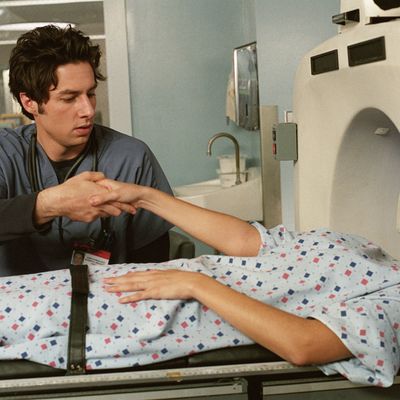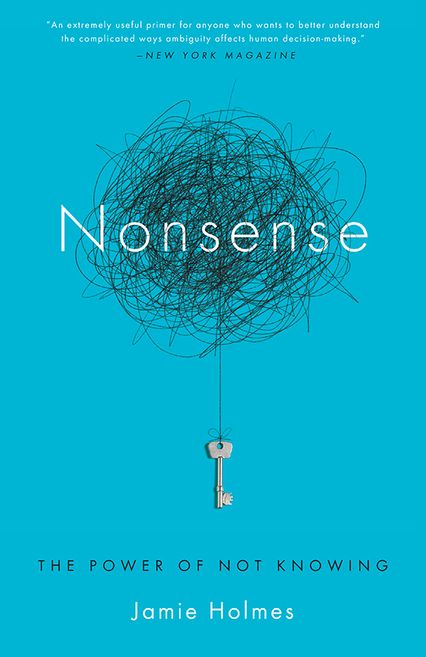
A few years ago, James Andrews — a famous sports medicine orthopedist — ran a clever quasi-experiment. Andrews has treated the likes of Drew Brees, Peyton Manning, Emmitt Smith, Charles Barkley, Michael Jordan, Roger Clemens, and Jack Nicklaus. Thinking that MRI scans might be giving doctors misleading results, Andrews took a group of thirty-one professional baseball players, all pitchers, and gave them MRIs. In twenty-seven of those pitchers, the MRI revealed abnormal rotator cuff damage. Twenty-eight of the pitchers showed abnormal shoulder cartilage.
The problem was that the pitchers were all healthy. Andrews had deliberately selected players who weren’t injured and hadn’t reported any pain. It turns out that MRIs are extraordinarily good at detecting abnormalities, but not always very good at revealing whether those abnormalities actually pose a problem.
“If you want an excuse to operate on a pitcher’s throwing shoulder, just get an MRI,” Andrews said. When the New York Times reported on that experiment in 2011, the story pointed to a critical downside of highly sensitive diagnostic tests. Pitchers, like all of us, have various physical flaws. But although the majority of these flaws are completely benign, the test’s hyperactive warning lights go off.
Patients are practically drowning in diagnostic tests. And yet in too many cases, the results simply don’t justify the rising number of CT, MRI, and PET imaging tests. In her 2007 book Overtreated, health policy expert Shannon Brownlee argued that “for every scan that helps a physician come to the right decision, another scan may cloud the picture, sending the doctor down the wrong path.”
Studies have showed that ordering a test can be a cheap response to unclear symptoms, providing a false sense of short-term closure. But if the test results are themselves unclear—if the warning lights aren’t always working—couldn’t that help propel a never-ending cycle of testing? A 2013 experiment run by Sunita Sah, Pierre Elias, and Dan Ariely suggests it could.
Sah speculated that ambiguous test results might lead doctors to order another test. In the case of the prostate-specific antigen (PSA) test for prostate cancer, she wondered: Could an inconclusive result lead to another, more risky, test? Sah, Elias, and Ariely recruited a group of over seven hundred men between the ages of 40 and 75 and randomly assigned them to one of four experimental conditions. The first group received information about the risks and benefits of a prostate biopsy. Then they were asked whether they would have a biopsy and how certain they were about their decision. The other three groups read about the risks and benefits of biopsies, too, but they also received background on the PSA screening test (which informs the decision of whether to have a biopsy) and were asked to imagine one of three PSA results: normal, elevated, or inconclusive. An inconclusive test result, subjects were informed, “provides no information about whether or not you have cancer.” The men then had to decide whether they would proceed with the hypothetical prostate biopsy.
In theory, an inconclusive PSA result shouldn’t make someone more or less likely to proceed with a risky biopsy. But that’s not what Sah and her colleagues found. Only 25 percent of subjects who weren’t given PSA screening results chose to proceed with the prostate biopsy. But 40 percent of subjects who received inconclusive PSA test results opted for the procedure. That’s a fairly large increase among those who received a result clearly explaining that it “provides no information.” Somehow, the very idea of not knowing something led to a panicky commitment to more invasive testing.

Since prostate biopsies are not only risky but also costly, the increased call for the biopsy is not insignificant. Sah described the problem as one of “investigation momentum.” In this and other analogous cases, we commit to an investigative course of action and receive ambiguous results, and since we’re especially averse to ambiguity under stress, we proceed with riskier diagnostic testing in the hopes of finding clear, anxiety-reducing answers.
Self-propelling momentum, Sah told me, results in “additional, potentially excessive diagnostic testing when you get a result that’s ambiguous.” She doesn’t deny that there are many other causes of overtesting in the United States. The financial incentives involved are obviously a mammoth issue, as is “defensive medicine,” where doctors treat patients to avoid potential lawsuits. But one important and overlooked cause, Sah said, is the self-propelling cascade of tests encouraged because of inconclusive results, ambiguity aversion, and a disproportionate faith in testing.
To the same point, in 2013 Deborah Grady cited evidence that in a US Department of Veteran Affairs (VA) medical center, the use of myocardial perfusion scans was inappropriate in about 20 percent of cases. That’s roughly the same rate as in other practices. But Grady, an editor at JAMA Internal Medicine, was pointing out that VA physicians are on salary and malpractice suits are rare. The matching rates imply that overtesting has deeper roots than financial incentives or defensive medicine.
In the past several years, medical journals have increasingly reported on instances where inconclusive test results led to additional risky tests or treatments. In one case, a man in his fifties with mild asthma needed hernia surgery. A preoperative evaluation came back normal, but as an extra precaution for a man of his age with asthma, a chest X-ray was ordered. It revealed a seven-millimeter nodule, a tiny mass of tissue, in the lung, which led a radiologist to order a CT scan. The lung nodule didn’t show up on the CT scan, but the scan revealed a different nodule in the man’s right adrenal gland. The radiologist then ordered another CT scan that was specifically focused on this area. The adrenal CT scan showed that the nodule was nothing to worry about. By the time he had his surgery, the man had endured the pain of a hernia for an extra six months, not to mention the worry that he might have cancer. What makes his case even worse is that the value of the first chest X-ray for patients fitting his profile has never been established. Yet the test spawned two additional tests, perfectly illustrating Sah, Elias, and Ariely’s concept of investigation momentum.
***
Medical professionals are aware of the overtesting problem and its various causes, and are working to correct it. Roughly $200 billion may be wasted in the United States annually on overtreatment, by one recent estimate. In a 2014 survey of physicians, 73 percent said that unnecessary tests and procedures are a serious health-care issue. Asked why they might occasionally make the mistake themselves, 36 percent said it was “just to be safe.” To be sure, medical uncertainties are especially emotional. The stakes are high, and we all know of situations in which persistent advocacy has paid off. The instinct to test “just in case” can’t and shouldn’t be entirely demonized. But we need a clearer weighing of risk and reward and a better balance between caring and overtreatment.
Leading the way, in 2010 JAMA Internal Medicine began running a series called Less Is More, detailing precisely when reducing medical care can have better health outcomes. The editors singled out diagnostic testing as one critical problem area. They know that abnormal but ultimately harmless findings on one test can lead to more testing and that every additional test or procedure imposes a psychological burden and carries a risk, often from complications or by exposing patients to radiation. As they put it in 2011, “no test (not even a non-invasive one) is benign, and often less is more.”
The difficulty of helping doctors make smarter choices also speaks to the limitations of patient empowerment. If well-meaning and pure-hearted doctors struggle with when and how to apply certain tests, how can we possibly expect patients to do better? Many patients don’t have the time or resources necessary to learn how to better navigate the complexities of the health-care system. And many patients aren’t in the right psychological state to take full responsibility for their health-care decisions.
Beyond spreading awareness of how ambiguity can interfere with effective diagnosis and treatment, the simplest — not to say the easiest — answer is to provide the right resources to both patients and doctors. In Minnesota, for example, the cooperative HealthPartners noticed annual 15 to 18 percent increases in MRI and CT scans. So they started a program in which the national radiology guidelines appear on patients’ electronic medical records every time a doctor orders a scan. After two years and change, the program had helped avoid an estimated 20,000 unnecessary tests and saved $14 million. Ratcheting up its less-is-more approach, JAMA Internal Medicine published top-five lists from the National Physicians Alliance, highlighting the key areas in which care could be markedly improved by less intervention. The lists are available online and often propose surprising don’ts. For instance, did you know that kids shouldn’t take cough and cold medications? There’s apparently little evidence that these over-the-counter medications reduce a cough or even shorten the duration of a cold. Yet one in 10 American children takes these medications weekly. Initiatives like these are adding critical lessons that we, as a society, have already begun to acknowledge: that frequent mammograms aren’t always needed, for instance, or that the dangers of certain drugs can outweigh their benefits.
Other recommendations speak directly to the epidemic of over-testing: don’t automatically order diagnostic scans for kids’ minor head injuries, don’t order Pap tests for women under twenty-one years old, don’t order annual electrocardiograms for patients with low risk for coronary heart disease, and unless there are red flags, don’t do imaging for lower back pain within the first six weeks. The ABIM Foundation, a nonprofit established by the American Board of Internal Medicine, set up a campaign called Choosing Wisely. The campaign asks various medical specialty societies to contribute top-five lists of things physicians and patients should question. So far, over sixty-five societies have helped identify more than 325 overused tests and procedures.
These efforts have been so successful that the Canadian Medical Association launched Choosing Wisely Canada in the spring of 2014. They’ve emphasized that the choice of fewer tests isn’t about rationing. Rather, it’s about the need to challenge the more-is-better mantra — about recognizing that despite technological advances, ordering tests isn’t always the best way to resolve a problem. Far too often, tests are a harmful crutch. In 2013, one study of resident doctors revealed that computers garnered over three times more face time than patients did.
Yet many diagnoses can be made simply by talking. As tempting as technological “certainty” feels, it’s usually wiser to treat the patient instead of the scan.
Reprinted from Nonsense: The Power of Not Knowing. Copyright © 2016 Jamie Holmes. Published by Broadway Books, an imprint of Penguin Random House LLC.




